This Sourdough Spelt Rosemary Loaf was inspired by a sourdough bread I sampled from one of the vendors at the Artisan Bread Festival during the Kneading Conference in Maine.
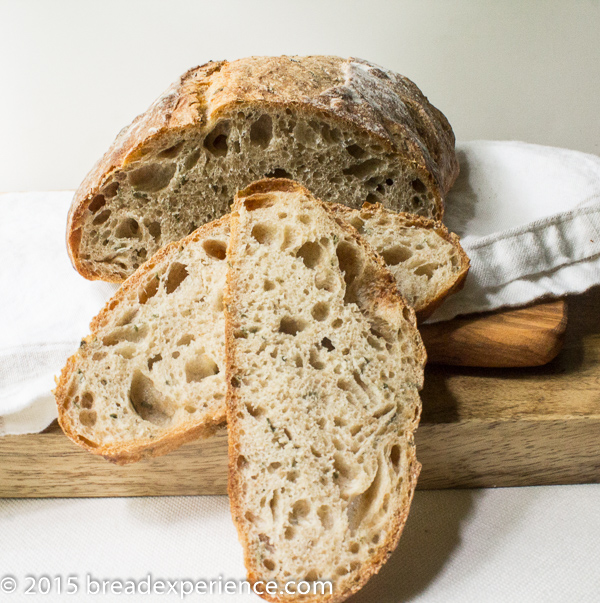
How this Sourdough Spelt Rosemary Loaf came to be
I attended the Artisan Bread Fair at the Kneading Conference in Maine and bought a Sourdough Rosemary Loaf from Borealis Bread. My youngest son and I enjoyed that loaf so much, I decided to try and recreate the experience.
The first time I made the bread, I used a mixture of sprouted wheat flour and all-purpose flour. My son said it was the best sourdough I had made. He’s been away at school and hasn’t tasted all of the recent sourdough bread I’ve made, but I’ll take the compliment.
I thought the flavor of the sprouted wheat version was great, but it didn’t get quite the rise/consistency I was aiming for so I decided to keep experimenting.
For the next loaf, I changed the percentage of whole wheat to all-purpose flour and incorporated wholegrain spelt flour instead of sprouted wheat flour. I kept the other variables the same.
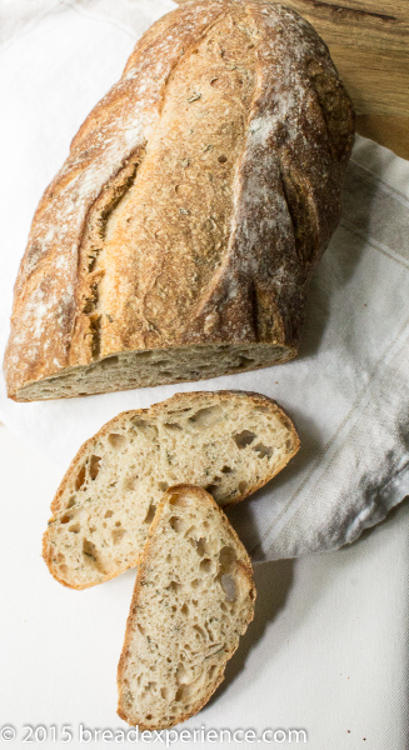
Tips regarding working with spelt flour
I chose spelt for this loaf due to some interesting tidbits I learned during the spelt workshop at the Kneading Conference.
For instance, spelt has a higher ratio of gliaden to glutenin as opposed to wheat which has a higher ratio of glutinen to gliadin.
I already knew that part, but what I didn’t know is that if you have a low protein wheat or a poor quality wheat, you can add some spelt to help strengthen it. Very cool, huh!
Spelt flour also works well when you leaven it with sourdough. I love the way the spelt performed in this loaf.
Since spelt makes a very delicate dough, it requires a shorter mixing time. And, gas accumulates faster so bread dough made with spelt should be slightly underproofed. Only let it proof until it looks almost perfect. If it looks perfect, it’s over proofed.
Another tip, which is true of all flours and all breads, is that experimentation is the key.
Take copious notes and make about 20-40 different batches using different variables. The last tip is mainly for bakeries, but home bakers need to experiment as well.
The saying “If at first you don’t succeed, try, try again” definitely applies to bread baking.
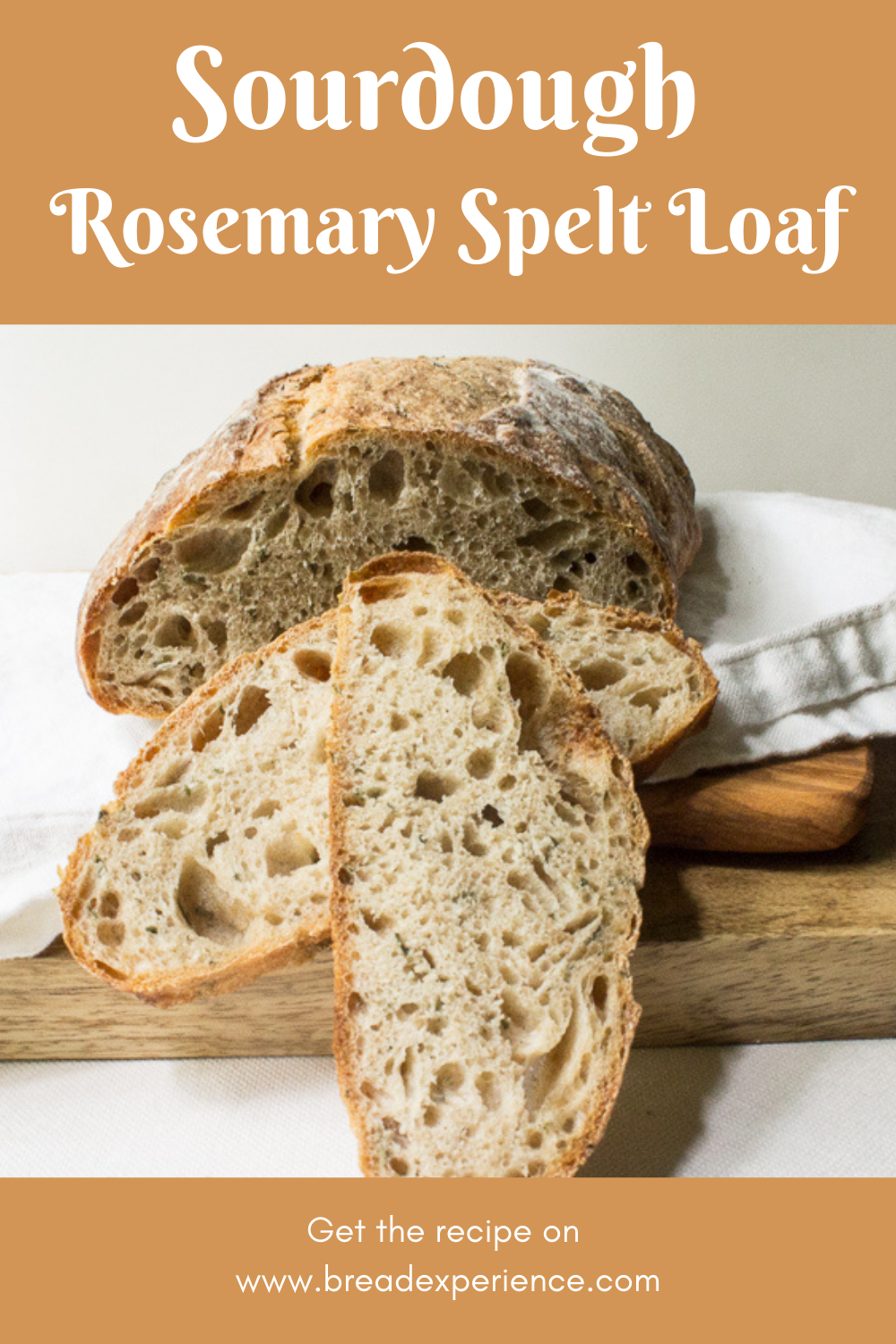
So far all of my experiments with this sourdough spelt rosemary loaf have produced good results in texture and flavor. I’m delighted to share it. It has a chewy and delicious crumb and a delightful rosemary aroma. I hope you enjoy this bread as much as I do.
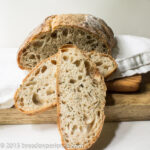
Sourdough Spelt Rosemary Loaf
- Yield: 1 Large Loaf 1x
Description
This Sourdough Spelt Rosemary Loaf is my recreation of a sourdough bread I bought from one of the vendors at the Maine Artisan Bread Festival.
Ingredients
Sourdough Build:
- 70 grams (2-3 Tbsp.) sourdough starter
- 70 grams (1/2 cup) all-purpose flour
- 70 grams (1/4 cup) warm water
Final Build:
- levain (all of the above)
- 250 grams (2 cups) all-purpose flour
- 150 grams (scant 1 3/8 cup) whole grain spelt flour
- 275 grams (1 1/8 cups) water
- 8 grams (~ 1 3/4 tsp.) fine sea salt
- 2–3 Tbsp. fresh rosemary, or to taste, chopped
Instructions
Sourdough Build:
- Add the sourdough starter to a medium bowl, pour in the warm water and stir to break up the starter. Mix in the flour and incorporate thoroughly using a wooden spoon or Danish dough whisk. Cover the mixture and let it rest overnight at room temperature for 8 – 12 hours or until ripe.
Final Build:
- The next day, mix together the levain and all but 50 grams of the water in a large bowl. Add in the flours and stir or whisk the ingredients until thoroughly combined.
- Add in the chopped rosemary and let the dough autolyse (rest) for 20 – 30 minutes, then add in the salt and the additional 50 grams of water and mix until the salt is completely incorporate into the dough.
- Cover the bowl and let the dough bulk ferment for 2 hours. Fold the dough 2 times at 30 minute intervals during the first hour. Let the dough rest the final hour.
- Shape the loaf into an oval shape or the shape of your choice and place it on parchment paper sprinkled with cornmeal. Alternately, place the dough in a brotform proofing basket sprinkled with rice flour. Let the loaf proof for 1-2 hours being careful not to let it overproof.
- At least 45 minutes before you plan to bake the loaf, preheat the oven to 450 degrees F. with a baking stone on the bottom rack and a steam pan or iron skillet on the top shelf.
- When the loaf is ready, score it down the middle or in the pattern of your choice and slide it and the parchment paper onto the preheated baking stone. Carefully add 4-5 ice cubes in the steam pan and immediately close the door.
- Bake the loaf 25-35 minutes. Partway through the bake cycle, remove the parchment paper and rotate the loaf for even browning. When done, the loaf should be browned and sound hollow when thumped on the bottom.
- Remove the loaf to a wire rack to cool completely before slicing and serving.
- Category: Sourdough
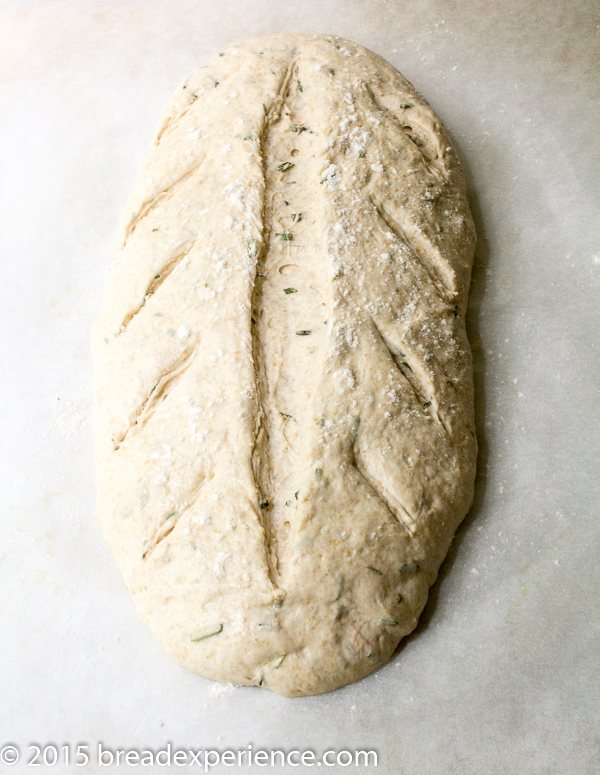
Happy Baking!
Cathy
Pam says
Being a new ‘baker’ what’s the best way for me to convert your directions into cups/ounces? What kind of scale?
Cathy says
Hi Pam,
I recommend using an online conversion calculator; however, keep in mind the weight measurements will be more accurate than the cups.
I use this online calculator https://www.thecalculatorsite.com/cooking/grams-cups.php
King Arthur Baking has a good conversion chart on their site as well.
I happen to have the conversions for this recipe already so I updated the post.
As far as the scale goes, I’ve used several over the years and upgraded as I could. I currently use the MyWeight KD-8000. I’ve had it for several years. You don’t have to go with anything fancy to begin with.
Happy Baking!
Cathy